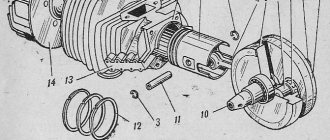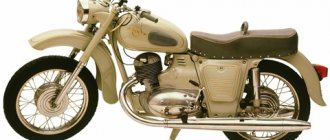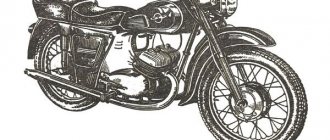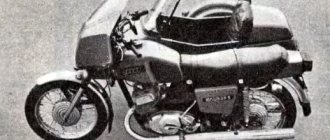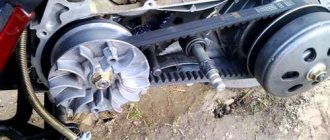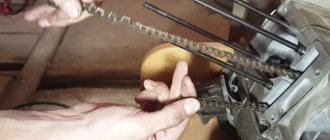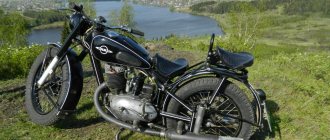Why is it worth ordering spare parts from us?
If you have already selected a suitable option, simply fill out the online form on the website, and if you can’t make a choice, call our consultants. Depending on the nature of the breakdown, we will help you decide on the purchase of rare spare parts for the Izh, Jupiter and Planet motorcycles. All specified components come with a quality guarantee. You will return your vehicle to working order with minimal investment of time and money.
The advantages of working with us are the extensive experience of our specialists in selecting components for Soviet motorcycles, the availability of even rare samples and the supply of only original and high-quality spare parts from reliable manufacturers.
Tuning the IZH Planet 5 engine for those who love their IZH
The legendary model of domestic motorcycle production appeared before the world 3 decades ago, but is still popular. What is the secret of success? Since that time, tuning the Izh motorcycle has captivated thousands of hundreds of motorcycle fans in the Soviet and then post-Soviet space.
Tuning the Izh motorcycle is complemented by excellent technical parameters. The two-wheeled miracle includes a 1-cylinder 2-stroke engine with a power of 22 hp. With. The fuel processing system operates at a modest 5 liters. gasoline consistently delivering 90 km/h. In addition, the model was among the first to receive an air cooling system, increasing traction at low speeds.
The IZH Planet engine lends itself perfectly to various kinds of modifications, and all in order to increase the power of our bike. Therefore, the issue of tuning the IZH Planet 5 engine is very acute.
But what is the best way to start tuning the IZH Planet 5 engine? And you need to start by repressing the crankshaft. It is necessary to replace the crankshaft main bearings with secondary shaft bearings from Java, this will increase the service life of this unit.
Next, in order to increase the working volume of the cylinder, it is necessary to cut off the upper part of the cylinder and bore the liner to 76 mm. A piston from IZH Planet Sport is perfect for this. After tuning the engine, Planet 5 will be able to drive 160 km/h. True, it will be a little scary to drive so fast on such a trough, but still.
A tuned engine will not be able to work with the basic clutch, especially the clutch disc and rear rubber. And this is understandable, because the loads will become higher, and the standard clutch is designed for standard loads. So you need to pull out the discs and replace them with thicker metal discs, this will prevent slipping. The heavier clutch will be offset by increased power and new capabilities.
As an option, when tuning IZH Planet 5, some craftsmen install supercharging, but this is a more complex job, we will talk about it later. In addition, we must remember that a new air filter will better clean the air, because improved air purification will affect the increase in power. Therefore, it is necessary to replace the standard air filter with one of the imported analogues.
Turbocharging on IZh Planet 5 And now let's move on to the almost impossible - putting turbocharging on Planet 5. First you will have to find out what the pump capacity is; in most cases it is 1750 l/min. That is why it is necessary to install a boost driven by the crankshaft, and the inflatable pump must have an impeller speed of at least 10,000 rpm.
When tuning the IZH Planet Sport engine, the exhaust resonator can be of great help to us, as it creates a back-up of the combustible mixture in the form of a resonant wave. And with the help of a slide valve, asymmetrical phases of motor operation will be obtained. To avoid possible problems, it is necessary to install fuel injection. The purging phase will be reduced so much that only the required amount of air will get there.
When tuning the IZH Planet 5 engine, piston lubrication is very useful to reduce friction. Particular load will be placed on the connecting rod roller bearing. The engine chain and crankshaft will not be balanced if the engine chain is slack, so it must be replaced. Under heavy loads, the clutch will not work as usual, which is why it is necessary to ensure that the textolite discs are without damage, and that there is no warping on the metal discs. If you have experience and hands, then you can make the IZH Planet 5 motorcycle very nimble. By the way, Java motorcycles are also great for tuning.
Once upon a time, IZH Planet was a symbol of motorcycling in the USSR. Now, this device is becoming less and less common on the roads. It's a pity. After all, with basic care, it is as reliable as a real Japanese. This article is about personal experience of more than 20,000 km on the Planet for those who want to operate this device like a motorcycle, and not like a museum piece. The article will have two parts (1) about technology (2) about operation. So, let's begin…
Part 1 – Technique
Planet is one of the simplest and most reliable devices produced in the USSR. Malfunctions, as a rule, are a consequence of gross violations of basic operating rules. Unfortunately, many people receive these motorcycles already in a heavily damaged condition and, even worse, with collective farm modifications, so it is often impossible for a new and inexperienced owner to determine the acquired defects from their characteristic features.
Update No. 4 In my case, Planet 2, produced in 1970, fell into my hands in 2000 as an inheritance from my grandfather and before that it had been collecting dust for about 15 years in disassembly. The actual mileage to me is estimated to be 40,000-50,000 km (with a sidecar) since the speedometer did not work. On this far from new vehicle, after repainting and reassembly (the chrome of the silencers and wheels was not restored due to cost), for 15 years and more than 20,000 km of my mileage, nothing has broken except the number plate, which was protected from vibrations.
So, the Planet (modifications 1,2,3,4,5) has fallen into your hands, how to make it work well:
1. Power system: be sure to install a fine fuel filter. A simple large filter from a Zhiguli (don’t take a small “motorcycle” one - it doesn’t have enough throughput). It is advisable to avoid gas hose loops according to the principle “the shorter the hose, the better” (see Fig. 1) - otherwise there will be air locks. We install the filter once and forget where the carburetor is located. For one thing, I recommend cleaning the sump of the gas tap. The oil must be two-stroke 1:50 - do not skimp and do not use motor oil (although according to the instructions it is permissible). Protects against the need to clean carbon deposits from under the head every 2000 km. The K-36I carburetor, after installing the fuel filter, did not require cleaning and adjustment even once over 20,000. The only problem identified was wear on the U-shaped brass spool. A groove is formed that prevents the spool from descending completely. Jammed gas is not a good thing. Therefore, I recommend monitoring and changing it every 15,000 km. Check that there was a pin under the spool cover during the break-in period that limits the gas flow; break it off if for some reason it remains. And we also check whether the type of carburetor generally corresponds to this modification of the Planet - there are known cases of installing carbs “from Java” and the like. If so, replace it with your native one.
2. Carburetor covers and spacer bolt: this is the main “life hack” of the Planet. From the factory, IZhi have aluminum caps covering the carburetor. Stupidly they throw it out. Put it back. There are two bonuses: (a.) A multiple reduction in vibrations at speeds over 80 km/h (those who have ridden it know what kind of vibrator this bike is) due to the 3rd point of attachment of the engine to the frame through a spacer bolt (see Fig. 1) ( b.) Less noticeable, but more fatal for the engine - much less dust gets into the air filter (before installing the covers, every 2000 km a hundred grams of sand were removed from the filter when cleaning) and, therefore, the piston service lasts many times longer. They say that 60,000 km without major repairs is not the limit. If you don’t have a native one, the spacer bolt can be made from an M12 or M10 bolt of a suitable length by cutting through the head. The bolt snaps into place when tightened and becomes the 3rd mounting point for the engine
Figure 1 Left view of the motor. The fuel filter with a short hose is clearly visible, as well as the spacer bolt of the carburetor caps under the tank
3. Air contact-oil filter . No wear and tear. It is critical to check the oil level once a season or after you drop the motor, to ensure that there are no cracks in the rubber and that the flange fits tightly to the carb. There is no need to clean it often if the lids are in place
4. Electrical equipment: both 12V and 6V (in my case) systems can work very reliably. At 6V it is advisable to solder the wires to the battery directly. It will solve a bunch of problems with poor terminal contact and voltage loss. Otherwise everything is reliable. We check that the bundles of wires have not been rubbed. Where necessary we wrap it with electrical tape/plastic clamps. At the same time, we control the mobility (pull up the wire - it should move) and the condition (it’s normal to have about 10mm brush length) of the carbon brushes of the generator rotor
5. Ignition: in this simple system there are several subtle points: - spark plugs: of the domestic ones, only A14 (the so-called “for the Volga” with a short thread - sold everywhere) from the Engel plant works normally. The rest is outright crap. Surely, foreign candles are good, but what's the point in paying more? Replacement every 2000 km. Then the oil finishes them off. We change. The color of the insulator is an indicator of the quality of the mixture: it should be cream. Black candle - rich mixture, white - poor - coil and high-voltage wire: the only identified problem is the insulation is aging / damp. If it doesn’t work, just replace it (by the way, the coil can be taken from Java. It’s a rare case when a non-original unit is justified) - breaker: it works for years without problems if oil does not get from the chain. If the contacts are worn out, replace them. Pay attention - there is a piece of felt / felt for lubricating the cam. One drop! Oils - ignition timing. According to the instructions 3.5-4mm. Set it to 2mm - it significantly reduces the kickback in the foot during winding, but the engine power does not have a noticeable effect. To set the ignition angle we will need: feeler gauges for measuring the gap, a caliper and a piece of newsprint. My method is this: set the gap of the breaker contacts to 0.4-0.6 mm using the feeler gauge, then insert a piece of paper between the contacts, rotate the crankshaft to top dead center (the contacts close together), measure the distance to the piston through the spark plug hole, rotate the crankshaft counterclockwise behind the rotor bolt, before the piece of paper can be moved and measure the distance again. The difference in measurements is the ignition timing - Electronic ignition: they say that you can install some kind of electronic ignition from something Chinese on the IZH. If so, it's worth a try. I do not recommend installing the ignition from Voskhod. The light will be very poor.
6. Exhaust system : the main recommendation is to remove the whistles from the silencer, if any were installed by the previous owners. The whistle was installed so that unburnt oil would not fall on the back. Pointless thing when using two-stroke oil. But it stops the engine from breathing and severely limits the power. Conducted. I recommend burning the muffler giblets with a blowtorch to remove carbon deposits for the same reasons.
7. The rear fork is the weak point of the Izhey at the point of attachment to the frame. It can be radically cured by installing 4x 201 bearings, instead of bushings (grooving is required), alternatively (as I did) the life of the fork is extended by installing an oiler for injection. Drill a hole between the feathers / make an M6 thread and fill in with grease
8. Rear shock absorbers: require an oil change every 4000-5000 km. You can fill in synthetic or semi-synthetic if you don’t have a special one. I took it apart, washed it in kerosene and filled it with a new one and reassembled it - everything was simple. Wrap the threads with fum tape so that the oil does not leak out
9. Front fork: the design is quite primitive. Oil leakage seems to be built into the design due to the use of rubber-felt seals. Periodically, every 5000 km we change the oil, 200 ml per feather. When purchasing, it is important to check the condition of the fork pipes and the absence of play. If there is - only replacement
10. Chain: It works in a rubber casing for a long time. Key: - you need to change the chain lock every 2000 km, as the pawl wears out. It costs a penny - it’s not worth repairing half a motor if the chain breaks because of it. Attention (!): the chain lock pawl is installed with a cut against the chain! An alternative is to use a chain rivet instead of a lock - the original drive star on the Planet is 18 teeth. I don’t recommend installing a 19 tooth from Jupiter - it doesn’t increase speed and you overload the motor. Personally, I prefer 17 teeth for off-road use due to low-speed traction - rubber corrugations: it is necessary to monitor the integrity and change when there are gusts. Better without corrugations than with torn ones. Dirt and oil quickly destroy the chain
11. Cylinder-piston group . The main indicator of the “liveness” of the engine is compression. There should be at least 6-7. If less, you need to replace the rings or bore the cylinder. Without compression it is pointless to talk about normal engine operation. When replacing the rings and removing the cylinder, check the play of the lower journal of the crankshaft - there should not be any. Otherwise, only replacement with a complete overhaul. Update No. 2 “- Mounting the cylinder head. If the bike was not driven on 2-stroke oil, we clean the combustion chamber of carbon deposits. Why do we remove the cylinder head? The peculiarity of the Planet is the absence of a labyrinthine seal. The seal is ensured flat to flat, so we don’t work when scratches appear on the aluminum. As a “repair”, a paronite gasket is often placed under the head, which is bad (risk of glow ignition, reduced compression ratio). I advise you to throw it away and rub the head on a flat surface (put fine sandpaper on a flat table, glass, etc.). At the same time, we will slightly raise the compression ratio to adapt to 80 gasoline. You won’t have to clean the combustion chamber with 2-stroke oil for 10,000 km or longer.”
Otherwise, the engine is reliable and requires only periodic oil changes in the box. Science knows of rare problems with flyaway gears, which can be treated by installing shims on the box shaft (fortunately, there is a separate box cover that allows this to be done without removing the engine from the frame and cutting it in half)
12. Engine mount is a problematic element. we control the tightening of the engine mounting bolts - especially the hard-to-reach rear support. It becomes loose and breaks the frame and the quarry.
13. Winding lever: control the tightening of the fastening bolt. If you miss it, it will break pretty quickly. But the main thing is Attention (!): we never start a motorcycle while sitting on it. The recoil can break your leg.
Update No. 1 14. Brakes: drum brakes with mechanical drive. — The rear ones can be quite effective. Secret two (1) pads must be clean of oil (comes from the chain casing if the oil seal is faulty). We wash it if there is anything in gasoline and change the oil seal. (2) But the main thing is to ensure a minimum gap between the pads and the drum. This is achieved by installing adjusting washers under the pad pad. Attention (!): due to the kinematics of the brake drive, when tightening the chain, it is necessary to loosen (adjust) the brake rod. otherwise the brake may start to jam. — The front brakes are quite weak. You have to press the lever with all your fingers if you want to slow down. My advice is to install a two-cam brake from IZH P5 (Yu5) - it is much more effective. You may lose a little in the authenticity of the device, but you will gain in safety. The secret is that in the P1-P4 single-claw brake drum, one block of the block works for tightening (and braking), and the other for pressing. In a two-cam, both pads work to tighten.
15. Frame: in principle, reliable on a single frame. When used with a stroller and under overload (and how could it be otherwise?), bending of the elements often occurs (see the patch on the muffler, which was worn by the winding stem for this reason, in the Photo in the header). Attention (!): I recommend checking before purchasing. It’s difficult to edit - just change
16. Other: the speedometer drive often fails at about 20,000 km. This is due to the design of the front wheel accelerating gearbox. Treated by replacing the small worm gear (and checking the large one for damage)
Everything else, including wheel bearings, oil level in the box, etc.
pretty standard. For motorcycles that have been used with a sidecar (and these are the majority), you should check the straightness of the frame before purchasing. In general, the Planet is a stable and reliable device. With careful use, it will take you to the southern meadows and northern mountains for years. I hope that the recommendations are useful to new IZh owners and will serve as a guide to their first actions. For those who have mastered this list, the next article will be devoted to the setup and operating features of the device. To be continued…


